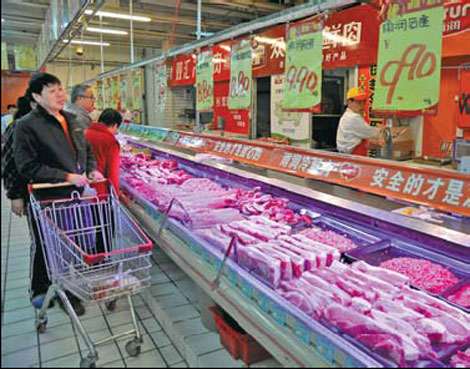Pork prices fall, forcing down inflation rate
|
Customers look at pork and other meat at a supermarket in Handan, Hebei province. Pork prices in 36 cities fell for six consecutive weeks up to April 1, and the government is increasing pork reserves to shore up the pig industry. Hao Qunying / For China Daily |
China's pork prices, which weigh heavily in inflation calculations, registered a sharp decline in March, putting downward pressure on the country's inflation while leading to widespread industry losses.
Pork prices started to decline in January. They have slumped 27 percent from this year's high and fallen 15 percent compared with the same period last year, industry data show.
By April 1, pork prices in 36 cities had been declining for six straight weeks, according to the Ministry of Commerce.
The drop in pork prices, a major component in the country's inflation calculations, put a dent in inflation rate this month, the National Bureau of Statistics said.
The consumer price index, a main gauge of inflation, accelerated 2.1 percent in March from a year earlier, dropping from 3.2 percent in February, the bureau said on Tuesday.
The figure was below economists' forecast of around 2.5 percent, and they said this will give the government more leeway to stimulate the economy.
"We are expecting moderate inflation and more flexible monetary policies in the second quarter," said Guan Qingyou, assistant dean of the Minsheng Securities Research Institute.
Analysts in the agricultural industry said the price decline was mainly caused by the weak demand and, pressed by rising costs for hog feeds, the industry is likely to see widespread losses.
Ji Guangxin, an analyst with Beijing-based SCI, a major portal for Chinese commodity information, said: "The hog market faces a problem of oversupply as farmers have a large number of hogs on hand, while pork consumption declined by 30 percent to 40 percent from the end of last year."
Grain prices, however, were on the increase, which bid up the feeds prices for the hog industry. The ratio of pork to grain prices surged to 5.6-to-1 by March 15, according to SCI's data. A ratio lower than 6-to-1 means a loss for farmers.
"The ratio has been staying at this level for the past four weeks, which means farmers and companies in the industry are facing losses," Ji added.
Ji also said the situation is expected to persist until the latter half of this year, and it is unlikely to see any substantial recovery in consumption.
"This might lead to further industry consolidation as big companies will take this opportunity to expand their scale," Ji said.
The National Development and Reform Commission, the country's top economic planning agency, recently said that if pork prices continue their downward trajectory, the government will increase national pork reserves in the next month to shore up prices.



















